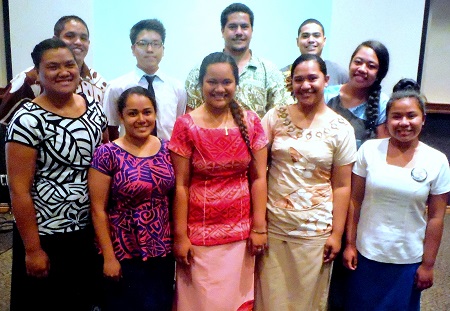
ASCC students, along with several from the local high schools, paticipated in the College's 6th Annual Science Symposium on Tuesday, November 10th. (Photo: J. Kneubuhl)

ASCC students, along with several from the local high schools, paticipated in the College's 6th Annual Science Symposium on Tuesday, November 10th. (Photo: J. Kneubuhl)
ASCC Holds 6th Annual Science Symposium
November 11, 2015
By James Kneubuhl, ASCC Press Officer
The Science Department at the American Samoa Community College (ASCC) held its 6th Annual Science Symposium this past Tuesday, November 10th. The event provided a forum for 11 young men and women from ASCC and the public high schools to give presentations on completed or ongoing science projects, many of them linked to the well-being of our local environment. “The purpose of the Symposium is to expose our science students to the general public and show what they’ve been doing scientifically,” said ASCC Science Department chairman Dr. Randel De Wees. “By doing this, we can showcase the scientific talent both at the College, and currently, the high schools.”
Student presentations at the Symposium covered a wide range of subjects. “Ways to Prevent Mynah Birds in a Piggery Farm,” by Janet Chang explored possible methods for preventing the invasive Mynah from consuming pig feed. Miss Chang had performed her research at the ASCC Community & Natural Resources division, along with fellow ASCC student Marlena Vailolo, who was unable to attend the event. Faatoia Areta posed the question, “Does Countershading Affect Predation Rate?” and gave a presentation on her efforts to determine whether the color patterns on an animal’s skin makes it more or less vulnerable to predators. Miss Areta researched this question while a participant in a student research program in Costa Rica this past summer.
June Talamoni and Fotu Kolona chose “Identifying Ways to Prevent Soil Erosion at the A-CNR Chicken Farm Area" as their presentation topic, based on their experience while taking classes with CNR. In a similar vein, Ikenasio Sagaga and Fatima Aneki, delved into “Comparing of the Palatability of Three Different Leaves for Supplementary Feeding of Pigs,” also based on their experiences working and studying at CNR. Johann Vollrath gave insight into the area of Marine Sciences with his presentation “Resilience comparison of 2 coral species in American Samoa (Pocillopora Damicornis and Porites Cylindrica) against temperature fluctuations,” in which he sought to determine which species of coral could longest withstand increases in ocean temperatures before bleaching.
Two ASCC students, Ernest Puletasi and Amber Ropeti, offered presentations on the work they did separately while both participated in another student research program this summer at Harvard University. They both entered the realm of highly advanced micro-technology, with Mr. Puletasi speaking on "Titanium Dioxide Thin-Films Deposited by Atomic Layer Deposition for Wave Guiding Applications" and Miss Ropeti describing the “Development of a Novel Sputter Technique Using Focus Ion Beam Microscopy.”
Two students from our local high schools rounded off the presentation roster. Hyun Duck Oh, a senior at South Pacific Academy, illuminated the "Attractiveness of Three Gravid Traps Infusions for Ovipositing Polynesian Tiger Mosquitoes (Aedes polynesiensis) In American Samoa," or in other words, what does or doesn’t interrupt the breeding cycle of mosquitoes. Finiana Finau, a junior at Samoana, discussed "The Effects of Barringtonia Asiatica and Derris Malaccensis on the Achantina Fulica,” which in layman’s terms explores the relative effectiveness of two locally grown varieties of poisonous leaves for the purposes of eradicating the African Snail.
“Participating in a Symposium benefits the student by allowing them to practice their presentations, since science students from here often are asked to present at other symposiums in locations like Hawaii, as many have already done,” said Dr. De Wees, who served as MC for the well-attended event. The ASCC Science chair explained that the Symposium was open to all students at the College who are engaged in scientific research, and that students at ASCC as well as the local high school who have received Louis Stokes Alliances for Minority Participation (LSAMP) funding for their projects were asked to give presentations on them.
“Overall, the Symposium offers a motivation to students to think deeper about science, as this depth is what it takes to synthesize the data and then formulate it into a presentation,” observed Dr. De Wees. “We are all made a little better by their efforts.”
